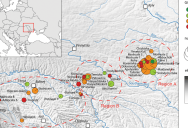The World’s First Cities Appear To Have Been Free Of Socially Inequality, But When Fairness Waned They Collapsed
by Trisha Leigh

If you think that social inequality is just a natural human behavior and therefore must have always been around, you might have to think again.
Recent research shows that earliest cities were likely free of social inequality, on the whole.
In fact, the first human megasites seem to have been completely egalitarian. Social equality could even be what attracted thousands of people to the prehistoric settlements.
It was likely the move away from parity that triggered the collapse of these ancient cities.

The “Trypillia megasites,” located in Ukraine, Moldova, and Romania, arose around 6,200 years ago in the Neolithic period. They covered over 790 acres of land and housed around 15,000 people at their most populated.
By 5,600 years ago, they were all but abandoned.
To figure out why, the authors of this study used Gini coefficients to assess household inequality inside the cities.
Gini coefficients are tools for detecting unevenness in social equality within a society. In this case, researchers used them to analyze variations in the floor sizes of more than 7,000 Trypillia houses.
“Assuming that the variability in the floor size of houses reflects differences in household wealth, we can discern a decline in social inequality in Trypillia communities until at least 3,800 BCE. The architecture of the houses shows a high degree of standardization, as do the furnishings of the houses and the economic activities detectable within.”

Image Credit: Cambridge
They go into more detail as to why they think this is significant.
“The round or oval layout of these settlements ensured equal access to structural elements and infrastructure. The presence of multifunctional assembly houses in public spaces indicates that the whole community may have participated in political decision-making process.”
And they don’t think it was done on accident, either.
“The development outlined here suggests that both an egalitarian ideology and effective mechanisms for avoiding social inequality must have existed within Trypillia communities. It implies intra-settlement mechanisms for reconciling interests and redistributing surpluses that might have been established collectively.”
They believe this is likely what attractive so many people to the communities in the first place.

Image Credit: Cambridge
As the spatial arrangements began to change, though, people began to leave.
“The demise of large Trypillia settlements and the formation of smaller communities in the surrounding regions starts just when social inequality begins to increase again. Thus, the end of the aggregated Trypillia communities and mega-sites coincided with when the mechanisms of social levelling and political participation began to fail and and social inequality re-emerged.”
If only we could figure out how to make people happy living together in society once again.
It would be hard, considering we’ve spent thousands of years going in the opposite direction.
If you think that’s impressive, check out this story about a “goldmine” of lithium that was found in the U.S. that could completely change the EV battery game.
Categories: HISTORY
Tags: · Gini coefficient, Neolithic period, science, single topic, social equality ancient world, top, Trypillia megasites

Sign up to get our BEST stories of the week straight to your inbox.




